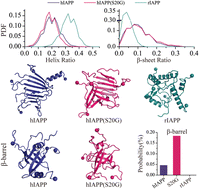Molecular insights into the oligomerization dynamics and conformations of amyloidogenic and non-amyloidogenic amylin from discrete molecular dynamics simulations†
Abstract
The amyloid aggregation of human islet amyloid polypeptide (hIAPP) is associated with pancreatic β-cell death in type 2 diabetes. The S20G substitution of hIAPP (hIAPP(S20G)), found in Japanese and Chinese people, is more amyloidogenic and cytotoxic than wild-type hIAPP. Rat amylin (rIAPP) does not have aggregation propensity or cytotoxicity. Mounting evidence suggests that soluble low-molecular-weight amyloid oligomers formed during early aggregation are more cytotoxic than mature fibrils. The self-assembly dynamics and oligomeric conformations remain unknown because the oligomers are heterogeneous and transient. The molecular mechanism of sequence-variation rendering dramatically different aggregation propensity and cytotoxicity is also elusive. Here, we investigate the oligomerization dynamics and conformations of amyloidogenic hIAPP, hIAPP(S20G), and non-amyloidogenic rIAPP using atomistic discrete molecular dynamics (DMD) simulations. Our simulation results demonstrated that all three monomeric amylin peptides mainly adopted an unstructured formation with partial dynamical helices near the N-terminus. Relatively transient β-hairpins were more abundant in hIAPP and hIAPP(S20G) than in rIAPP. The S20G-substituting mutant of hIAPP altered the turn region of the β-hairpin motif, resulting in more hydrophobic residue-pairwise contacts within the β-hairpin. Oligomerization dynamic investigation revealed that all three peptides spontaneously accumulated into helix-populated oligomers. The conformational conversion to form β-sheet-rich oligomers was only observed in hIAPP and hIAPP(S20G). The population of high-β-sheet-content oligomers was enhanced by S20G substitution. Interestingly, both hIAPP and hIAPP(S20G) could form β-barrel formations, and the β-barrel propensity of hIAPP(S20G) was three times larger than that of hIAPP. No β-sheet-rich or β-barrel formations were observed in rIAPP. Our direct observation of the correlation between β-barrel oligomer formation and cytotoxicity suggests that β-barrels might play a critically important role in the cytotoxicity of amyloidosis.

- This article is part of the themed collection: 2022 PCCP HOT Articles


 Please wait while we load your content...
Please wait while we load your content...